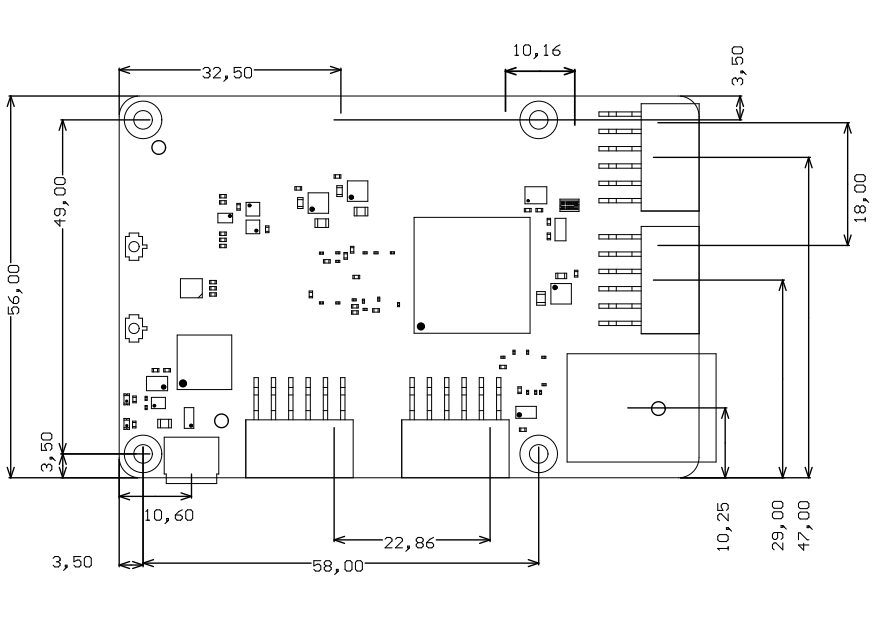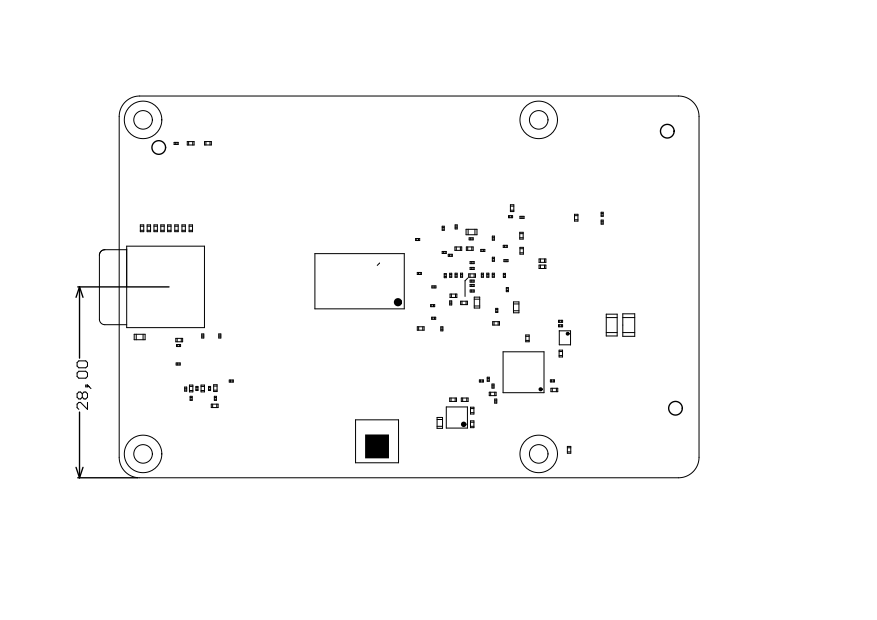Table of Contents
<!-- Template Revision 1.66 (HTML comments will be not displayed in the document, no need to remove them. For Template/Skeleton changes, increase Template Revision number. So we can check faster, if the TRM style is up to date). --> |
<!-- General Notes: If some section is CPLD firmware dependent, make a note and if available link to the CPLD firmware description. It's in the TE shop download area in the corresponding module -> revision -> firmware folder. --> |
<!-- General Notes: Designate all graphics and pictures with a number and a description. For example "Figure 1: TE07xx-xx Block Diagram" or "Table 1: Initial delivery state". "Figure x" and "Table x" have to be formatted to bold. --> |
Table of Contents |
<!-- Wiki Link: Go to Base Folder of the Module or Carrier, for example : https://wiki.trenz-electronic.de/display/PD/TE0712 --> |
Refer to https://wiki.trenz-electronic.de/display/PD/<name> for the current online version of this manual and other available documentation. |
The Trenz Electronic TEM0002-01 SmartBerry with Raspberry Pi form factor, is an industrial-grade module based on Microsemi SmartFusion2 SoC (System on a Chip). The Module has 128MB DDR3 SDRAM, a Gigabit Ethernet PHY, four PMODs, a GPIO Pin header compatible to the Raspberry Pi pinout and a Micro USB to UART interface. SmartFusion2 combines a 166 MHz Cortex-M3 core with 256 KByte Flash, 80 KByte SRAM and a 12 kLUT FPGA core logic.
Additional assembly options are available for cost or performance optimization upon request.

Figure 1: TEM0002-01 block diagram.


Figure 2: TEM0002-01 main components.
Storage device name | Content | Notes |
|---|---|---|
| Microsemi SmartFusion2 SoC FPGA, U2 | Demo Design | - |
| EEPROM, U6 | Programmed | FTDI (FT2232H) configuration data. |
Table 1: Initial delivery state of programmable devices on the module.
The SmartBerry supports
<!-- Connections and Interfaces or B2B Pin's which are accessible by User --> |
I/O signals provided on the Rasperry Pi compatible header are connected to bank 2 of the Microsemi SoC.
| I/O Signal Count | Bank Voltage | Notes |
|---|---|---|
| 26 I/Os | 3.3V |
Table 2: General overview of I/O signals connected to the SoC.
Further I/Os are provided via the PMOD connectors descriebed below.
The module provides four 2x6 female PMOD connectors. Two of the headers (P2 and P3) are arranged to use as dual 12 pin PMOD. According to the standard on all four headers Pin 5 and 11 are connected to ground, 6 and 12 to 3.3V.
| FPGA SoC Signal | Pin | Label | PMOD Signal | PMOD Signal |
|---|---|---|---|---|
| MSIO71PB7 | U2-F3 | P1 | PB-01 | PB-01 |
| MSIO71NB7 | U2-F4 | P1 | PB | PB-02 |
| MSIO68NB7 | U2-E3 | P1 | PC | PB-03 |
| MSIO80NB7 | U2-H4 | P1 | PD | PB-04 |
| MSIO75PB7 | U2-G4 | P1 | PB-05 | |
| MSIO70PB7 | U2-E1 | P1 | PB-06 | |
| MSIO67NB7 | U2-E5 | P1 | PB-07 | |
| MSIO78NB7 | U2-G3 | P1 | PB-08 | |
| MSIO79PB7 | U2-G1 | P2 | PC-01 | |
| MSIO79NB7 | U2-F1 | P2 | PC-02 | |
| MSIO70NB7 | U2-E2 | P2 | PC-03 | |
| MSIO64PB7 | U2-C1 | P2 | PC-04 | |
| MSIO78PB7 | U2-G2 | P2 | PC-05 | |
| MSIO70PB7 | U2-E1 | P2 | PC-06 | |
| MSIO68PB7 | U2-D2 | P2 | PC-07 | |
| MSIO64NB7 | U2-C2 | P2 | PC-08 | |
| MSIO117NB4 | U2-Y16 | P3 | PA-01 | |
| MSIO117PB4 | U2-Y15 | P3 | PA-02 | |
| MSIO112PB4 | U2-W13 | P3 | PA-03 | |
| MSIO110PB4 | U2-V12 | P3 | PA-04 | |
| MSIO118PB4 | U2-W15 | P3 | PA-05 | |
| MSIO112NB4 | U2-W14 | P3 | PA-06 | |
| MSIO105NB4 | U2-Y13 | P3 | PA-07 | |
| MSIO105NB4 | U2-Y13 | P3 | PA-08 | |
| MSIO4PB2 | U2-P20 | P4 | PD-01 | |
| MSIO3NB2 | U2-R20 | P4 | PD-02 | |
| MSIO2NB2 | U2-T19 | P4 | PD-03 | |
| MSIO0PB2 | U2-V20 | P4 | PD-04 | |
| MSIO6NB2 | U2-P19 | P4 | PD-05 | |
| MSIO3PB2 | U2-T20 | P4 | PD-06 | |
| MSIO1NB2 | U2-U19 | P4 | PD-07 | |
| MSIO0NB2 | U2-V19 | P4 | PD-08 |
JTAG access to the SoC components is provided through the micro usb connector via the FTDI usb to UART bridge. Depending on the jumper J6 the JTAGSEL signal SW3 switches the JTAG interface to either the FPGA fabric TAP (open, high) or the Cortex-M3 JTAG debug interface (closed, low). JTAG signals are powered by 3.3V.
FTDI signal | pin | JTAG Signal | Microsemi SmartFusion2 SoC FPGA pin |
|---|---|---|---|
| ADBUS0 | U3-12 | TCK | U2-W19 |
| ADBUS1 | U3-13 | TDI | U2-V16 |
| ADBUS2 | U3-14 | TDO | U2-Y20 |
| ADBUS3 | U3-15 | TMS | U2-V17 |
Table 5: JTAG interface signals.
The SD Card interface is connected to Bank 2 of the SoC
| FPGA / SoC Pin | Connected To | Signal Name | Notes |
|---|---|---|---|
| U2-H16 | J3-9 | SD_CD | Card detect switch |
| U2-N15 | J3-7 | SD_D0 | |
| U2-G18 | J3-8 | SD_D1 | |
| U2-R16 | J3-1 | SD_D2 | |
| U2-R17 | J3-2 | SD_D3 | |
| U2-R15 | J3-3 | SD_CMD | |
| U2-P15 | J3-5 | SD_CLK |
Table 6: SD Card interface signals and connections.
On board Gigabit Ethernet PHY is provided with ...
Ethernet PHY connection
| PHY Pin | PS | PL | B2B | Notes |
|---|---|---|---|---|
Table x: ...
On-board I2C devices are connected to MIO.. and MIO.. which are configured as I2C... by default. I2C addresses for on-board devices are listed in the table below:
| I2C Device | I2C Address | Notes |
|---|---|---|
Table x: I2C slave device addresses.
<!-- Components on the Module, like Flash, PLL, PHY... --> |
TEM0002 has 1Gb industrial grade DDR3 SDRAM (U5) in a 16-bit wide memory bus providing total of 128 MBytes of on-board RAM.
The Datasheet notes 800 MHz clocking resulting in 1600 Mb/s data rate and timing specification of 11-11-11 (CL-TRCD-TRP).
On-board Gigabit Ethernet PHY (J2) is provided by Microsemi VSC8531 chip (U1). The Ethernet PHY RGMII interface is connected to Bank 6 of the Microsemi SOC. I/O voltage is fixed at 1.5V. The reference clock input of the PHY is supplied from an external 25.000000 MHz oscillator (U11).
The module has following reference clock signals provided by on-board oscillators:
| Clock Source | Schematic Name | Frequency | Clock Destination |
|---|---|---|---|
| Crystal CX3225CA25000D0HSSCC | Y1 | 25.000 MHz | SmartFusion2 SoC U2 Main XTAL |
| Crystal ECX-31B | Y2 | 32.768 KHz | SmartFusion2 SoC U2 AUX XTAL |
| SiTime SiT8008AI oscillator | U11 | 25.000000 MHz | Gb Ethernet Copper PHY U1A |
| SiTime SiT8008AI oscillator | U14 | 25.000000 MHz | SmartFusion2 SoC U2-Y12 Bank 4 |
Table : Reference clock signals.
In REV02, Y1 will be replaced by a 12MHz crystal.
| LED | Color | Connected to | Description and Notes |
|---|---|---|---|
| D1 | Red | U2-G16 Bank 1 | |
| D2 | Green | U2-G17 Bank 1 | |
| D3 | RGB | U2-H5 Bank 7, U2-F6 Bank 7, U2-H6 Bank 7 | |
| J2 | Green, Yellow | U2-Y10 Bank 4, U2-U12 Bank 4 | Ethernet: LED1A, LED1B |
| J2 | Green, Yellow | U2-V14 Bank 4, U2-U14 Bank 4 | Ethernet: LED2A, LED2B |
Table : On-board LEDs.
<!-- If power sequencing and distribution is not so much, you can join both sub sections together --> |
The maximum power consumption of a module mainly depends on the design running on the FPGA.
| Power Input | Typical Current |
|---|---|
| VIN | TBD* |
| 3.3VIN | TBD* |
Table : Typical power consumption.
* TBD - To Be Determined soon with reference design setup.
Power supply with minimum current capability of ...A for system startup is recommended.
For the lowest power consumption and highest efficiency of the on-board DC-DC regulators it is recommended to power the module from one single 3.3V supply. All input power supplies have a nominal value of 3.3V. Although the input power supplies can be powered up in any order, it is recommended to power them up simultaneously.
Regulator dependencies and max. current.
Put power distribution diagram here...
Figure : Module power distribution diagram.
See Xilinx data sheet ... for additional information. User should also check related base board documentation when intending base board design for TE07xx module.
The TE07xx SoM meets the recommended criteria to power up the Xilinx Zynq MPSoC properly by keeping a specific sequence of enabling the on-board DC-DC converters dedicated to the particular functional units of the Zynq chip and powering up the on-board voltages.
Following diagram clarifies the sequence of enabling the particular on-board voltages, which will power-up in descending order as listed in the blocks of the diagram:
Put power-on diagram here...
Figure : Module power-on diagram.
If the module has one, describe it here...
NB! Following table with examples is valid for most of the 4 x 5 cm modules but depending on the module model and specific design, number and names of power rails connected to the B2B connectors may vary.
Power Rail Name | B2B JM1 Pins | B2B JM2 Pins | Direction | Notes |
|---|---|---|---|---|
| VIN | 1, 3, 5 | 2, 4, 6, 8 | Input | Main supply voltage from the carrier board. |
| 3.3V | - | 10, 12, 91 | Output | Module on-board 3.3V voltage supply. (would be good to add max. current allowed here if possible) |
| B64_VCO | 9, 11 | - | Input | HR (High Range) bank voltage supply from the carrier board. |
VBAT_IN | 79 | - | Input | RTC battery supply voltage from the carrier board. |
| ... | ... | ... | ... | ... |
Table : Module power rails.
Different modules (not just 4 x 5 cm ones) have different type of connectors with different specifications. Following note is for Samtec Razor Beam™ LSHM connectors only, but we should consider adding such note into included file in Board to Board Connectors section instead of here.
Current rating of Samtec Razor Beam™ LSHM B2B connectors is 2.0A per pin (2 adjacent pins powered). |
Bank | Schematic Name | Voltage | Voltage Range |
|---|---|---|---|
| 500 (MIO0) | PS_1.8V | 1.8V | - |
| 501 (MIO1) | PS_1.8V | 1.8V | - |
| 502 (DDR3) | 1.35V | 1.35V | - |
| 12 HR | VCCIO_12 | User | HR: 1.2V to 3.3V |
| 13 HR | VCCIO_13 | User | HR: 1.2V to 3.3V |
| 33 HP | VCCIO_33 | User | HP: 1.2V to 1.8V |
| 34 HP | VCCIO_34 | User | HP: 1.2V to 1.8V |
| 35 HP | VCCIO_35 | User | HP: 1.2V to 1.8V |
Table : Module PL I/O bank voltages.
<!-- Generate new entry: Replace with correct on for selected module series --> |
NB! Note that here we look at the module as a whole, so you just can't rely only on junction temperature or max voltage of particular SoC or FPGA chip on the module. See examples in the table below.
| Module Variant | FPGA / SoC | Operating Temperature | Temperature Range |
|---|---|---|---|
| TE0710-02-35-2CF | XC7A35T-2CSG324C | 0°C to +70°C | Commercial |
| TE0715-04-30-3E | XC7Z030-3SBG485E | 0°C to +85°C | Extended |
| TE0841-01-035-1I | XCKU035-1SFVA784I | –40°C to +85°C | Industrial |
| .. | .. | .. | .. |
Table : Module variants.
Parameter | Min | Max | Units | Reference Document |
|---|---|---|---|---|
VIN supply voltage | V | - | ||
Storage temperature | °C | - |
Table : Module absolute maximum ratings.
| Assembly variants for higher storage temperature range are available on request. |
| Parameter | Min | Max | Units | Reference Document |
|---|---|---|---|---|
| VIN supply voltage | ||||
| Operating temperature |
Table : Module recommended operating conditions.
| Please check Xilinx datasheet ... for complete list of absolute maximum and recommended operating ratings. |
Commercial grade: 0°C to +70°C.
Extended grade: 0°C to +85°C.
Industrial grade: -40°C to +85°C.
Module operating temperature range depends also on customer design and cooling solution. Please contact us for options.
Module size: 85 mm × 56 mm. Please download the assembly diagram for exact numbers.
PCB thickness: 1.55 mm.
Highest part on PCB: top approx. 13.3 mm (Ethernet), bottom 1.57mm (SD-Card)Please download the step model for exact numbers.
All dimensions are given in millimeters.


Figure : Module physical dimensions drawing.
| Date | Revision | Notes | PCN | Documentation Link |
|---|---|---|---|---|
| - | 01 | Prototypes |
Table : Module hardware revision history.
Hardware revision number can be found on the PCB board together with the module model number separated by the dash.
Put picture of actual PCB showing model and hardware revision number here...
Figure : Module hardware revision number.
<!-- Generate new entry: 1.add new row below first 2.Copy "Page Information Macro(date)" Macro-Preview, Metadata Version number, Author Name and description to the empty row. Important Revision number must be the same as the Wiki document revision number 3.Update Metadata = "Page Information Macro (current-version)" Preview+1 and add Author and change description. --> |
Date | Revision | Contributors | Description |
|---|---|---|---|
| John Hartfiel | Remove Link to Download | ||
2017-05-30 | v.1 | Jan Kumann | Initial document. |
all | Jan Kumann, John Hartfiel |
Table : Document change history.